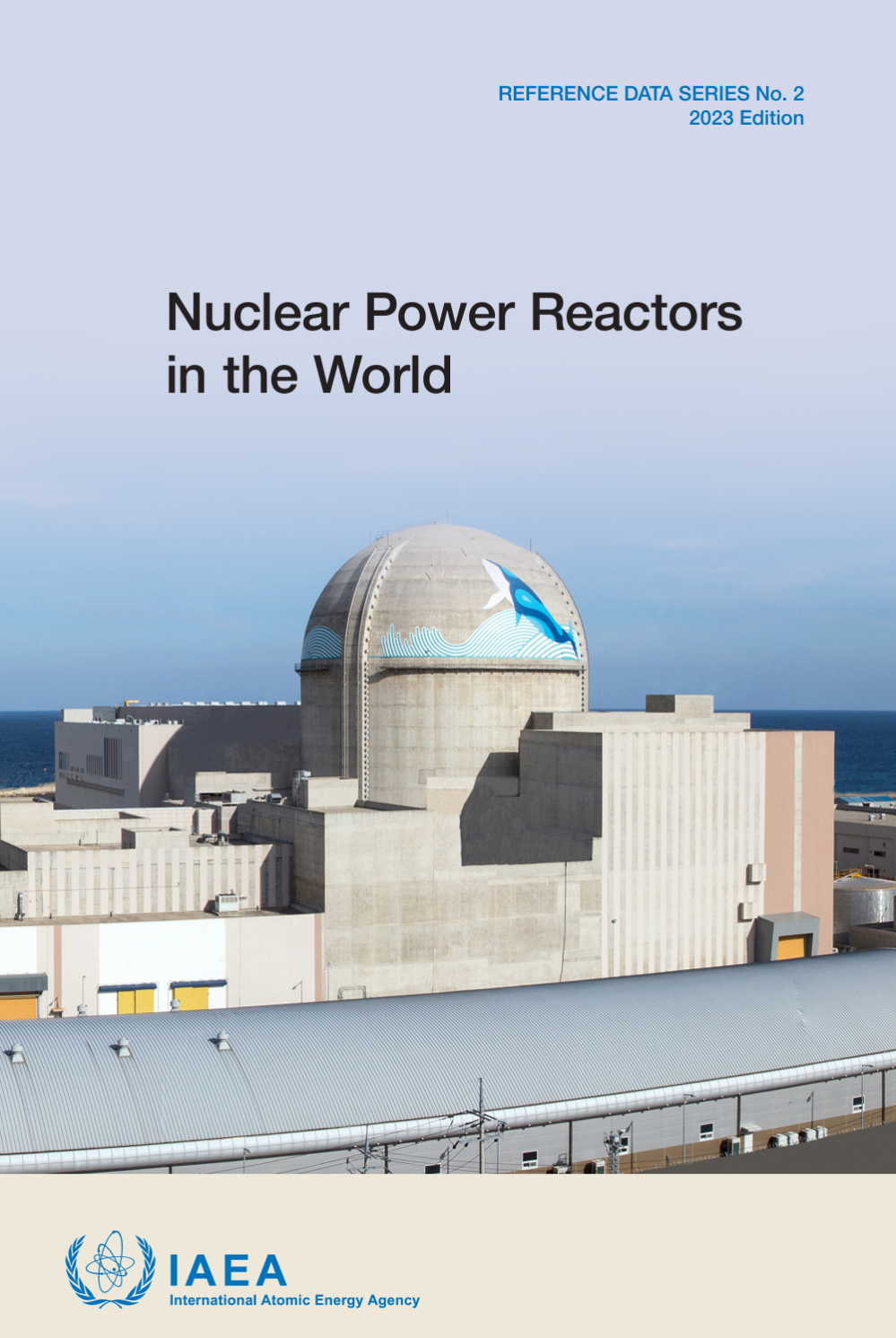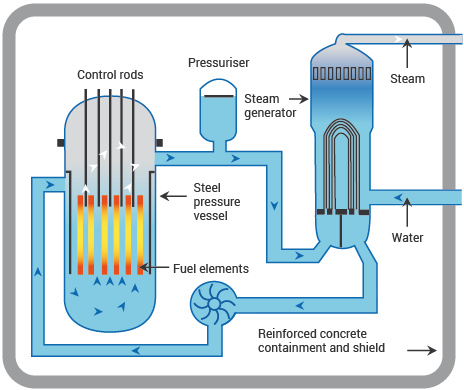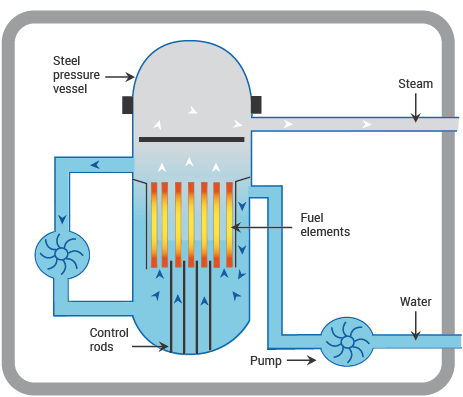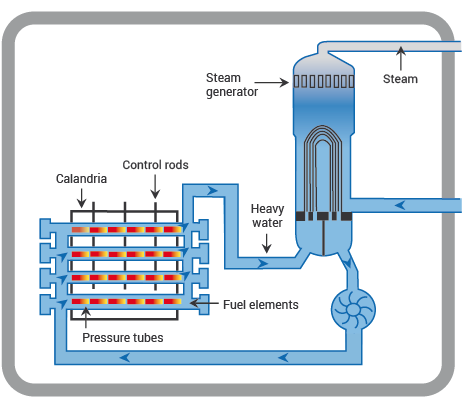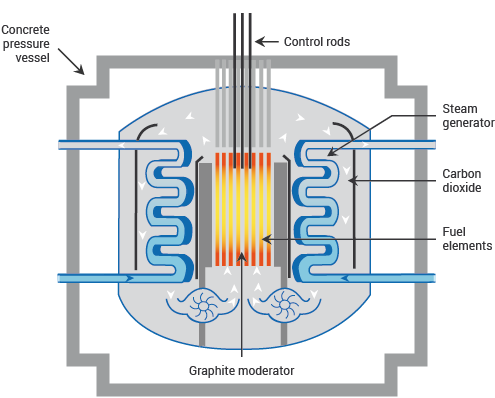Nuclear Power Reactors in the World / IAEA 2023 - Nuclear power reactors worldwide May 2024
| News | ||||||||||||||||||||||||||||||||||||||||||||||||||||||||||
| 17 Maggio 2025 | ||||||||||||||||||||||||||||||||||||||||||||||||||||||||||
| Salve Visitatore | ||||||||||||||||||||||||||||||||||||||||||||||||||||||||||
|
Nuclear Power Reactors in the World / IAEA 2023 Edition ID 22157 | 02.07.2024 / Documenti allegati IAEA 2023 Edition This is the 43rd edition of Reference Data Series No. 2, which presents the most recent reactor data available to the IAEA. It contains summarized information as of the end of 2022 on power reactors operating, under construction and shut down as well as performance data on reactors operating in the IAEA Member States. The information is collected through designated national correspondents in the Member States and the data are used to maintain the IAEA's Power Reactor Information System (PRIS). Fonte: IAEA 2024 Operable nuclear power reactors worldwide / May 2024 Number of operable nuclear power reactors worldwide as of May 2024, by country ID 22157 | 02.07.2024 - World Nuclear Association - Download scheda As of May 2024, there were 440 nuclear reactors in operation in 32 countries around the world. The United States had the largest number of nuclear power reactors in operation at the time, at 94 units. Operable nuclear reactors refer to those that are connected to the grid. Operation of a nuclear reactor A nuclear reactor produces and controls the release of energy from splitting the atoms of certain elements. In a nuclear power reactor, the energy released is used as heat to make steam to generate electricity. (In a research reactor the main purpose is to utilize the actual neutrons produced in the core. In most naval reactors, steam drives a turbine directly for propulsion.) The principles for using nuclear power to produce electricity are the same for most types of reactor. The energy released from continuous fission of the atoms of the fuel is harnessed as heat in either a gas or water, and is used to produce steam. The steam is used to drive the turbines which produce electricity (as in most fossil fuel plants). The world's first nuclear reactors 'operated' naturally in a uranium deposit about two billion years ago. These were in rich uranium orebodies and moderated by percolating rainwater. The 17 known at Oklo in west Africa, each less than 100 kW thermal, together consumed about six tonnes of uranium. It is assumed that these were not unique worldwide. Today, reactors derived from designs originally developed for propelling submarines and large naval ships generate about 85% of the world's nuclear electricity. The main design is the pressurized water reactor (PWR) which has water at over 300°C under pressure in its primary cooling/heat transfer circuit, and generates steam in a secondary circuit. The less numerous boiling water reactor (BWR) makes steam in the primary circuit above the reactor core, at similar temperatures and pressure. Both types use water as both coolant and moderator, to slow neutrons. Since water normally boils at 100°C, they have robust steel pressure vessels or tubes to enable the higher operating temperature. (Another type uses heavy water, with deuterium atoms, as moderator. Hence the term ‘light water’ is used to differentiate.) Components of a nuclear reactor There are several components common to most types of reactor: Fuel * In a new reactor with new fuel a neutron source is needed to get the reaction going. Usually this is beryllium mixed with polonium, radium or other alpha-emitter. Alpha particles from the decay cause a release of neutrons from the beryllium as it turns to carbon-12. Restarting a reactor with some used fuel may not require this, as there may be enough neutrons to achieve criticality when control rods are removed. Moderator Control rods or blades * In fission, most of the neutrons are released promptly, but some are delayed. These are crucial in enabling a chain reacting system (or reactor) to be controllable and to be able to be held precisely critical. Coolant Pressure vessel or pressure tubes Steam generator * These are large heat exchangers for transferring heat from one fluid to another – here from high-pressure primary circuit in PWR to secondary circuit where water turns to steam. Each structure weighs up to 800 tonnes and contains from 300 to 16,000 tubes about 2 cm diameter for the primary coolant, which is radioactive due to nitrogen-16 (N-16, formed by neutron bombardment of oxygen, with half-life of 7 seconds). The secondary water must flow through the support structures for the tubes. The whole thing needs to be designed so that the tubes don't vibrate and fret, operated so that deposits do not build up to impede the flow, and maintained chemically to avoid corrosion. Tubes which fail and leak are plugged, and surplus capacity is designed to allow for this. Leaks can be detected by monitoring N-16 levels in the steam as it leaves the steam generator. Containment Newer Russian and some other reactors install core melt localisation devices or 'core catchers' under the pressure vessel to catch any melted core material in the event of a major accident. There are several different types of reactor as indicated in the following table. Fuelling a nuclear reactor Most reactors need to be shut down for refuelling, so that the reactor vessel can be opened up. In this case refuelling is at intervals of 12, 18 or 24 months, when a quarter to a third of the fuel assemblies are replaced with fresh ones. The CANDU and RBMK types have pressure tubes (rather than a pressure vessel enclosing the reactor core) and can be refuelled under load by disconnecting individual pressure tubes. The AGR is also designed for refuelling on-load. If graphite or heavy water is used as moderator, it is possible to run a power reactor on natural instead of enriched uranium. Natural uranium has the same elemental composition as when it was mined (0.7% U-235, over 99.2% U-238), enriched uranium has had the proportion of the fissile isotope (U-235) increased by a process called enrichment, commonly to 3.5-5.0%. In this case the moderator can be ordinary water, and such reactors are collectively called light water reactors. Because the light water absorbs neutrons as well as slowing them, it is less efficient as a moderator than heavy water or graphite. Some new small reactor designs require high-assay low-enriched uranium fuel, enriched to near 20% U-235. During operation, some of the U-238 is changed to plutonium, and Pu-239 ends up providing about one-third of the energy from the fuel. In most reactors the fuel is ceramic uranium oxide (UO2 with a melting point of 2800°C) and most is enriched. The fuel pellets (usually about 1 cm diameter and 1.5 cm long) are typically arranged in a long zirconium alloy (zircaloy) tube to form a fuel rod, the zirconium being hard, corrosion-resistant and transparent to neutrons.* Numerous rods form a fuel assembly, which is an open lattice and can be lifted into and out of the reactor core. In the most common reactors these are about 4 metres long. A BWR fuel assembly may be about 320 kg, a PWR one 655 kg, in which case they hold 183 kg uranium and 460 kgU respectively. In both, about 100 kg of zircaloy is involved. * Zirconium is an important mineral for nuclear power, where it finds its main use. It is therefore subject to controls on trading. It is normally contaminated with hafnium, a neutron absorber, so very pure 'nuclear grade' Zr is used to make the zircaloy, which is about 98% Zr plus about 1.5% tin, also iron, chromium and sometimes nickel to enhance its strength. A significant industry initiative is to develop accident-tolerant fuels which are more resistant to melting under conditions such as those in the Fukushima accident, and with the cladding being more resistant to oxidation with hydrogen formation at very high temperatures under such conditions. Burnable poisons are often used in fuel or coolant to even out the performance of the reactor over time from fresh fuel being loaded to refuelling. These are neutron absorbers which decay under neutron exposure, compensating for the progressive build up of neutron absorbers in the fuel as it is burned, and hence allowing higher fuel burn-up (in terms of GW days per tonne of U)*. The best known is gadolinium, which is a vital ingredient of fuel in naval reactors where installing fresh fuel is very inconvenient, so reactors are designed to run more than a decade between refuellings (full power equivalent – in practice they are not run continuously). Gadolinium is incorporated in the ceramic fuel pellets. An alternative is zirconium diboride integral fuel burnable absorber (IFBA) as a thin coating on normal pellets. * Average burn-up of fuel used in US reactors has increase to nearly 50 GWd/t, from half that in the 1980s. Gadolinium, mostly at up to 3g oxide per kilogram of fuel, requires slightly higher fuel enrichment to compensate for it, and also after burn-up of about 17 GWd/t it retains about 4% of its absorbtive effect and does not decrease further. The ZrB2 IFBA burns away more steadily and completely, and has no impact on fuel pellet properties. It is now used in most US reactors and a few in Asia. China has the technology for AP1000 reactors. Main types of nuclear reactor Pressurised water reactor (PWR) This is the most common type, with about 300 operable reactors for power generation and several hundred more employed for naval propulsion. The design of PWRs originated as a submarine power plant. PWRs use ordinary water as both coolant and moderator. The design is distinguished by having a primary cooling circuit which flows through the core of the reactor under very high pressure, and a secondary circuit in which steam is generated to drive the turbine. In Russia these are known as VVER types – water-moderated and -cooled. A pressurized water reactor (PWR) Source: World Nuclear Association A PWR has fuel assemblies of 200-300 rods each, arranged vertically in the core, and a large reactor would have about 150-250 fuel assemblies with 80-100 tonnes of uranium. Water in the reactor core reaches about 325°C, hence it must be kept under about 150 times atmospheric pressure to prevent it boiling. Pressure is maintained by steam in a pressuriser (see diagram). In the primary cooling circuit the water is also the moderator, and if any of it turned to steam the fission reaction would slow down. This negative feedback effect is one of the safety features of the type. The secondary shutdown system involves adding boron to the primary circuit. The secondary circuit is under less pressure and the water here boils in the heat exchangers which are thus steam generators. The steam drives the turbine to produce electricity, and is then condensed and returned to the heat exchangers in contact with the primary circuit. Boiling water reactor (BWR) This type of reactor has many similarities to the PWR, except that there is only a single circuit in which the water is at lower pressure (about 75 times atmospheric pressure) so that it boils in the core at about 285°C. The reactor is designed to operate with 12-15% of the water in the top part of the core as steam, and hence with less moderating effect and thus efficiency there. BWR units can operate in load-following mode more readily than PWRs. The steam passes through drier plates (steam separators) above the core and then directly to the turbines, which are thus part of the reactor circuit. Since the water around the core of a reactor is always contaminated with traces of radionuclides, it means that the turbine must be shielded and radiological protection provided during maintenance. The cost of this tends to balance the savings due to the simpler design. Most of the radioactivity in the water is very short-lived*, so the turbine hall can be entered soon after the reactor is shut down. * mostly N-16, with a 7 second half-life A BWR fuel assembly comprises 90-100 fuel rods, and there are up to 750 assemblies in a reactor core, holding up to 140 tonnes of uranium. The secondary control system involves restricting water flow through the core so that more steam in the top part reduces moderation. A boiling water reactor (PWR) Source: World Nuclear Association Pressurised heavy water reactor (PHWR) The PHWR reactor has been developed since the 1950s in Canada as the CANDU, and from 1980s also in India. PHWRs generally use natural uranium (0.7% U-235) oxide as fuel, hence needs a more efficient moderator, in this case heavy water (D2O).** The PHWR produces more energy per kilogram of mined uranium than other designs, but also produces a much larger amount of used fuel per unit output. ** with the CANDU system, the moderator is enriched (i.e. water) rather than the fuel – a cost trade-off. The moderator is in a large tank called a calandria, penetrated by several hundred horizontal pressure tubes which form channels for the fuel, cooled by a flow of heavy water under high pressure (about 100 times atmospheric pressure) in the primary cooling circuit, typically reaching 290°C. As in the PWR, the primary coolant generates steam in a secondary circuit to drive the turbines. The pressure tube design means that the reactor can be refuelled progressively without shutting down, by isolating individual pressure tubes from the cooling circuit. It is also less costly to build than designs with a large pressure vessel, but the tubes have not proved as durable. A pressurized heavy water reactor (PWR) Source: World Nuclear Association A CANDU fuel assembly consists of a bundle of 37 half metre long fuel rods (ceramic fuel pellets in zircaloy tubes) plus a support structure, with 12 bundles lying end to end in a fuel channel. Control rods penetrate the calandria vertically, and a secondary shutdown system involves adding gadolinium to the moderator. The heavy water moderator circulating through the body of the calandria vessel also yields some heat (though this circuit is not shown on the diagram above). Newer PHWR designs such as the Advanced Candu Reactor (ACR) have light water cooling and slightly-enriched fuel. CANDU reactors can accept a variety of fuels. They may be run on recycled uranium from reprocessing LWR used fuel, or a blend of this and depleted uranium left over from enrichment plants. About 4000 MWe of PWR might then fuel 1000 MWe of CANDU capacity, with addition of depleted uranium. Thorium may also be used in fuel. Advanced gas-cooled reactor (AGR) These are the second generation of British gas-cooled reactors, using graphite moderator and carbon dioxide as primary coolant. The fuel is uranium oxide pellets, enriched to 2.5 - 3.5%, in stainless steel tubes. The carbon dioxide circulates through the core, reaching 650°C and then past steam generator tubes outside it, but still inside the concrete and steel pressure vessel (hence 'integral' design). Control rods penetrate the moderator and a secondary shutdown system involves injecting nitrogen to the coolant. The high temperature gives it a high thermal efficiency – about 41%. Refuelling can be on-load. An advanced gas-cooled reactor (AGR) Source: World Nuclear Association The AGR was developed from the Magnox reactor. Magnox reactors were also graphite moderated and CO2 cooled, used natural uranium fuel in metal form, and water as secondary coolant. The UK's last Magnox reactor closed at the end of 2015. Light water graphite-moderated reactor (LWGR) The main LWGR design is the RBMK, a Soviet design, developed from plutonium production reactors. It employs long (7 metre) vertical pressure tubes running through graphite moderator, and is cooled by water, which is allowed to boil in the core at 290°C and at about 6.9 MPa, much as in a BWR. Fuel is low-enriched uranium oxide made up into fuel assemblies 3.5 metres long. With moderation largely due to the fixed graphite, excess boiling simply reduces the cooling and neutron absorbtion without inhibiting the fission reaction, and a positive feedback problem can arise, which is why they have never been built outside the Soviet Union. See appendix on RBMK Reactors for further information. Fast neutron reactor (FNR) Some reactors do not have a moderator and utilise fast neutrons, generating power from plutonium while making more of it from the U-238 isotope in or around the fuel. While they get more than 60 times as much energy from the original uranium compared with normal reactors, they are expensive to build. Further development of them is likely in the next decade, and the main designs expected to be built in two decades are FNRs. If they are configured to produce more fissile material (plutonium) than they consume they are called fast breeder reactors (FBR). Operable nuclear power plants
Advanced reactors |
||||||||||||||||||||||||||||||||||||||||||||||||||||||||||
 |
||||||||||||||||||||||||||||||||||||||||||||||||||||||||||
|
è un sito di INVIO NEWSLETTTER Se vuoi cancellarti dall'invio della newsletter oppure effettua il login al sito ed entra nella Tua Area Riservata, in “Modifica dati” agisci con la spunta sul box di selezione “Newsletter”. L'Elenco completo di tutte le ns newsletter è qui: Archivio newsletter |
||||||||||||||||||||||||||||||||||||||||||||||||||||||||||
  |
||||||||||||||||||||||||||||||||||||||||||||||||||||||||||
| Certifico Srl 2000-2025 | VAT IT02442650541 | ||||||||||||||||||||||||||||||||||||||||||||||||||||||||||

































